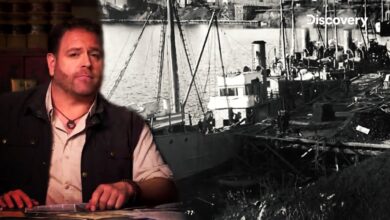Josh Discovers Ancient Buried Inscription Devoted to Apostle Peter | Expedition Unknown | Discovery
Josh Discovers Ancient Buried Inscription Devoted to Apostle Peter | Expedition Unknown | Discovery

Whoop whoop whoop.
Yes. Look at this black mosaic right here.
This is the inscription.
Yeah. Oh my word.
And this floor that we’re revealing right now.
This was laid down when.
Was laid down at the end of the sixth century.
So we are revealing a 1400-year-old inscription.
Exactly. This is what we do in archaeology.
Millimeter by millimeter.
We expose ancient letters from beneath the soil.
But making them legible is going to take a little more work.
What’s the next step?
The next step is washing it.
Okay. Please, Steve.
With the dirt swept away.
All it takes is some water and elbow grease for the past to shine through.
Wow. Look at that.
Oh, it’s just coming to life.
That’s unbelievable.
Can I see the scrubber? Sure.
If it looks like we shouldn’t be doing this.
Don’t worry. The mosaic has lasted 14 centuries in a harsh world.
A little spit and polish ain’t going to hurt it.
Wow, my brain is exploding right now.
It looks like it was written just a few hours ago.
It really does.
I can’t describe what an honor it is to be able to see this, and to reveal it to the world in its entirety for the very first time.
This is unbelievable.
I mean, look at this.
It’s extraordinary.
The entire inscription is here.
Not a letter is missing.
In the news articles.
I saw like a corner of this, but not the whole thing, really.
This is the first time publicly it’s being shown clearly.
This is the first time the world has seen this in 1400 years.
Yeah.
Amazing, isn’t it? Huh?
It’s unreal.
Okay, now the big question.
What does it say?
I read Ancient Greek about as well as I swing dance.
Fortunately, Steve and Moti have Professor Jacob Ashkenazi on hand to do the translating.
Okay, so, professor, help us out here.
What does this say?
The word here.
Kappa Omicron Rho.
It means the chief.
Of what? Right.
The chief of.
What? Of Apostalon.
The apostles.
The apostles.
Chief of the apostles.
Peter. Peter.
Peter is Peter.
Nobody else.
He’s the chief of the apostles.
Okay.
The Apostle Peter, who of course was from Bethsaida, was first among equals in Jesus’ devout dozen.
It was to Peter that Jesus would entrust his church, and to whom he gave the keys to the kingdom of heaven.
Now I’m reading his title right here on the floor.
So there is no doubt at all that we are talking about Peter.
Zero doubt.
How common is it to find an inscription like this?
That is a dedication to Saint Peter.
Zero.
This has not happened before.
This is a unique one.
So when you first found this, what was your reaction?
It’s not the smoking gun. It’s a bomb.
Okay. We have hundreds of years after the time of the apostles in the Byzantine era.
This beautiful basilica is built here and appears to be dedicated to the Apostle Peter.
Yes. So why would they have done that?
I think the church here commemorates the home of Peter, Andrew, and Philip.
Byzantine churches like this were frequently placed atop sites believed to have been the locations of biblical events.
Hence, the churches became destinations for pilgrims.
This is very compelling evidence.
This is something you don’t often get at an archaeological site in the Holy Land, a complete inscription.
One word is missing: Bethsaida.
Right.
That’s it. If it said Bethsaida, then it would be a done deal.
But just short of that, there is yet hope for finding that one word.
The basilica’s mosaic floor continues outward, and it could contain more inscriptions.
Here we have only pieces of the mosaic floor.
And here we have a wall.
This is a later wall. It is from the 12th-13th century Crusader period.
The wall is covering the original mosaic.
And since an inscription could confirm that this is Bethsaida, the choice is simple.
The wall has got to go.
Anything could be under here.
There’s always surprises in archaeology.
That’s right. Okay, so should we see what’s there?
Let’s go. Let’s move the wall.




